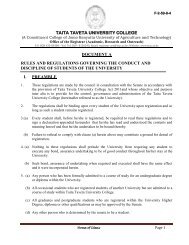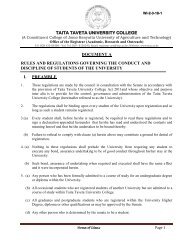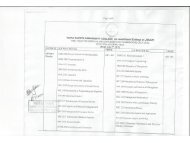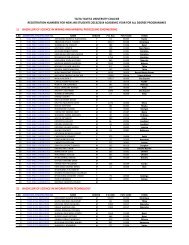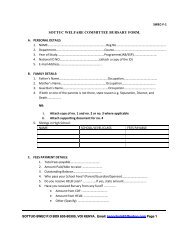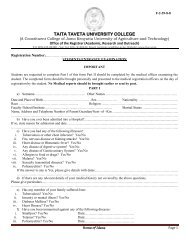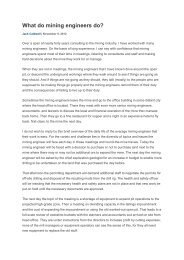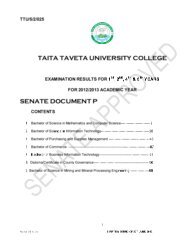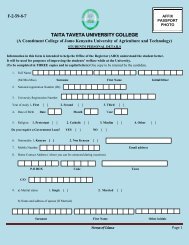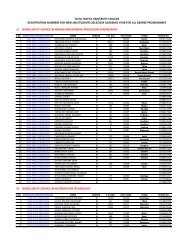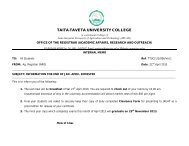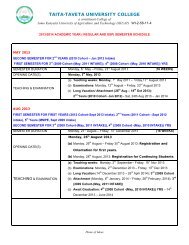Conference Book of Abstracts - Taita Taveta University College
Conference Book of Abstracts - Taita Taveta University College
Conference Book of Abstracts - Taita Taveta University College
- No tags were found...
You also want an ePaper? Increase the reach of your titles
YUMPU automatically turns print PDFs into web optimized ePapers that Google loves.
populations, habitats (including occurrence, and spatial distribution data), in addition tomolecules. In parallel to this informatics infrastructure, the technique <strong>of</strong> using a standardizedsection <strong>of</strong> an organism‟s genome, known as DNA barcoding, emerged at the beginning <strong>of</strong> thelast decade. DNA, as the genetic material in most living organisms, is transferred fromgeneration to generation. Differences among organisms have their basis in this genetic material,and this can be used to distinguish them. DNA barcoding is an approach that uses standardizedsegments <strong>of</strong> nucleic material for species identification. Using DNA has the advantage <strong>of</strong> beinglife stage independent, allowing for example identification <strong>of</strong> immature stages (e.g. insect larvaewhich <strong>of</strong>ten have fewer diagnostic characters than adults), identifying the diet <strong>of</strong> an animal basedon stomach contents, cryptic species among disease vectors, matching parasitoids and pests,studying tri-trophic interactions (pests, plants and parasitoids), tracking invasive species, oridentifying products in commerce (for example, herbal supplements or wood). A „DNA-Barcode‟ is analogous to a product barcode in the supermarket, which carries information aboutthe product, including its contents, quantities and price. In a similar way, the barcode datastandard demands a set <strong>of</strong> requirements for acceptance that take into account the data quality andcompleteness in order to incorporate sequences and metadata. These data are aggregated in thebarcode <strong>of</strong> life datasystems repository (http://barcodinglife.org), which to date holds nearly 2million specimen records. These developments in biodiversity informatics are already increasingthe pace <strong>of</strong> species discovery, and influencing biodiversity conservation policy and practice.Natural Products Research as a Tool for Poverty AlleviationJosphat MatasyohChemistry Department, Egerton <strong>University</strong>, P. O. Box 536, Egerton – 20115. Kenya.Email address: josphat2001@yahoo.comAfrica is endowed with a lot <strong>of</strong> natural resources that can be utilized to solve a myriad <strong>of</strong>problems facing it. It has a rich biodiversity that remain untapped. In order for Africa especiallySub-Saharan Africa to achieve the Millennium Development Goals (MDG‟s) and Kenya, inparticular, to achieve Vision 2030, there will be need for a sustainable use <strong>of</strong> local resources todevelop local solutions to our problems. Poverty in this region may be narrowed down to issues<strong>of</strong> food and health security. While most peasant farmers harvest adequate food to last themthrough the season, nearly 30% <strong>of</strong> it is destroyed by storage insect pests and moulds. In the area<strong>of</strong> health, malaria still remains one <strong>of</strong> the major killer diseases especially for children under theage <strong>of</strong> five years. The MDG‟s cannot, therefore, also be achieved without efforts towardseradication <strong>of</strong> this disease. In an effort to contribute to local solutions to the provision <strong>of</strong> foodand health security to Kenyans, we embarked on the search for biodiversity resources availablein Kenya that have utilizable bio-activity. Research findings towards the management <strong>of</strong> postharvestlosses due to insect pests and moulds; including the malaria vector control will be disc



